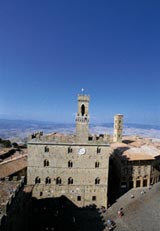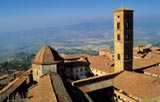|


Volterra, gioiello d’arte etrusca, romana, medievale e
rinascimentale, domina da un colle di 550 metri tutta la valle
del Cecina, fino al mare.
A Volterra la storia ha lasciato il suo segno con continuità
dal periodo etrusco fino all’ottocento, con testimonianze
artistiche e monumentali di grandissimo rilievo, che possono
essere ammirate semplicemente passeggiando per le vie del
centro storico, ma anche visitando i tre musei cittadini: il
Museo Etrusco, la Pinacoteca Civica e il Museo d’Arte Sacra.
Accanto a queste un paesaggio incontaminato, una qualità della
vita ancora a dimensione umana e un artigianato artistico
unico al mondo: l’alabastro. Una città da vivere intensamente,
da scoprire a poco a poco, con le sue atmosfere, i suoi
contrasti, il pulsare di una civiltà e di una cultura che la
rendono “unica” e irripetibile.
La meta ideale per un soggiorno in Toscana, alla scoperta di
una delle zone più incontaminate della regione che è nello
stesso tempo a un passo dal mare e dalle più importanti città
d’arte. |

Volterra, a haven of Etruscan, Roman, Medieval and
Rennaissance art, domi- nates the Cecina Valley, 550 metres
above sea level, affording a spectacular view as far as the
sea.
The city still retains traces of its majestic past which
gradually unfurls as you wander through the narrow streets and
explore the Etruscan Museum, The Art Gallery and Museum of
Sacred Art.
And yet Volterra’s charm not only lies in its historical
patrimony but in the undefiled surrounding countryside, a slow
traditional way of life and its age-old tradition of alabaster
carving.
This elusive stronghold requires careful and patient attention
for it takes time to absorb its timeless atmosphere, treasured
secrets, unique ambience and culture.
One of the most unspoilt areas in the region, close to other
important art centres and the coast, this is an ideal choice
for a holiday in Tuscany.
 |


Volterra, ein Juwel der etruskischen (Stadt mauer mit Stadttor,
Gräber), römischen (das Theater) und mittelalterlichen (Marktplatz
mit dem ältesten Rathaus Italiens und den Wohntürmen) Kunst
bis zur Renaissance, beherrscht auf einem 550 m hohen Hügel
liegend das ganze Cecinatal bis zum Meer.
Um die architektonischen und künstlerischen Werke zu bewundern
reicht ein Spaziergang durch die Stadt und der Besuch der drei
Museen: dem etruskischen Museum, der städtischen
Gemäldegalerie (Pinacotheka) und dem Museum d’Arte Sacra.
Daneben eine noch ursprüngliche Landschaft, eine angenehme Art
zu leben wie in alten Zeiten und ein einmaliges Kunsthandwerk,
den Alabaster.
Eine einzigartige Stadt, in der es viel zu entdecken gibt und
die nur langsam die Geheimnisse ihrer Zivilisation und ihrer
Kultur preisgibt.
Der ideale Aufenthaltsort für einen Urlaub in der Toskana,
noch fern vom hektischen Tourismus, aber in der Nähe des
Meeres und der wichtigsten Kunststädte. |